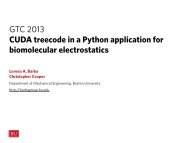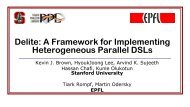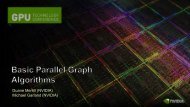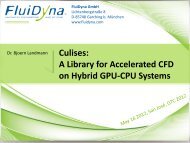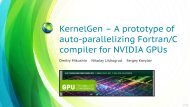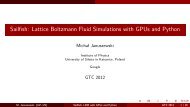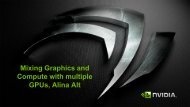GPU Performance Analysis and Optimization - GPU Technology ...
GPU Performance Analysis and Optimization - GPU Technology ...
GPU Performance Analysis and Optimization - GPU Technology ...
- No tags were found...
Create successful ePaper yourself
Turn your PDF publications into a flip-book with our unique Google optimized e-Paper software.
Goals of This Talk• Give insight into how hardware operates– Fermi <strong>and</strong> Kepler• Connect hardware operation to performance• Provide guidelines for diagnosing <strong>and</strong> optimizingperformance limiters– Illustrate the use with brief case studies• some Fermi, some Kepler• Quick review of things to keep in mind whentransitioning from Fermi to Kepler© 2012, NVIDIA2
Determining <strong>Performance</strong> Limiter for a Kernel• Kernel performance is limited by one of:– Memory b<strong>and</strong>width– Instruction b<strong>and</strong>width– Latency• Usually the culprit when neither memory nor instruction throughput is a highenoughpercentage of theoretical b<strong>and</strong>width• Determining which limiter is the most relevant for your kernel– Not really covered in this presentation due to time– Covered in more detail in session 2012 of GTC2010:• Slides: 5-19, 45-49• Link: http://www.nvidia.com/content/GTC-2010/pdfs/2012_GTC2010v2.pdf• Video: http://nvidia.fullviewmedia.com/gtc2010/0923-san-jose-2012.html© 2012, NVIDIA5
Topics For Ninjas• Topics relevant to 1% (or less) of codes <strong>and</strong> developers– So, if you’re not trying to squeeze out the last few % ofperformance, you can ignore these• Indicated with the following logo:© 2012, NVIDIA6
Main Requirements for <strong>GPU</strong> <strong>Performance</strong>• Expose sufficient parallelism• Coalesce memory access• Have coherent execution within warp© 2012, NVIDIA7
EXPOSING SUFFICIENT PARALLELISM© 2012, NVIDIA8
Kepler: Level of Parallelism Needed• To saturate instruction b<strong>and</strong>width:– Fp32 math: ~1.7K independent instructions per SM– Lower for other, lower-throughput instructions– Keep in mind that Kepler SM can track up to 2048 threads• To saturate memory b<strong>and</strong>width:– 100+ independent lines per SM© 2012, NVIDIA9
Memory Parallelism• Achieved Kepler memory thoughput– As a function of the number of independent requests per SM– Request: 128-byte line© 2012, NVIDIA10
Exposing Sufficient Parallelism• What hardware ultimately needs:– Arithmetic pipes:• sufficient number of independent instructions– accommodates multi-issue <strong>and</strong> latency hiding– Memory system:• sufficient requests in flight to saturate b<strong>and</strong>width• Two ways to increase parallelism:– More independent work within a thread (warp)• ILP for math, independent accesses for memory– More concurrent threads (warps)© 2012, NVIDIA11
Occupancy• Occupancy: number of concurrent threads per SM– Expressed as either:• the number of threads (or warps),• percentage of maximum threads• Determined by several factors– (refer to Occupancy Calculator, CUDA Programming Guide for full details)– Registers per thread• SM registers are partitioned among the threads– Shared memory per threadblock• SM shared memory is partitioned among the blocks– Threads per threadblock• Threads are allocated at threadblock granularityKepler SM resources– 64K 32-bit registers– Up to 48 KB of shared memory– Up to 2048 concurrent threads– Up to 16 concurrent threadblocks© 2012, NVIDIA12
Occupancy <strong>and</strong> <strong>Performance</strong>• Note that 100% occupancy isn’t needed to reach maximumperformace– Once the “needed” occupancy is reached, further increases won’timprove performance• Needed occupancy depends on the code– More independent work per thread -> less occupancy is needed– Memory-bound codes tend to need more occupancy• Higher latency than for arithmetic, need more work to hide it– We’ll discuss occupancy for memory- <strong>and</strong> math-bound codes laterin the presentation© 2012, NVIDIA13
Exposing Parallelism: Grid Configuration• Grid: arrangement of threads into threadblocks• Two goals:– Expose enough parallelism to an SM– Balance work across the SMs• Several things to consider when launching kernels:– Number of threads per threadblock– Number of threadblocks– Amount of work per threadblock© 2012, NVIDIA14
Threadblock Size <strong>and</strong> Occupancy• Threadblock size is a multiple of warp size (32)– Even if you request fewer threads, HW rounds up• Threadblocks can be too small– Kepler SM can run up to 16 threadblocks concurrently– SM may reach the block limit before reaching good occupancy• Example: 1-warp blocks -> 16 warps per Kepler SM (probably not enough)• Threadblocks can be too big– Quantization effect:• Enough SM resources for more threads, not enough for another large block• A threadblock isn’t started until resources are available for all of its threads© 2012, NVIDIA15
Threadblock SizingToo fewthreadsper blockNumber of warps allowed by SM resources• SM resources:– Registers– Shared memoryToo manythreadsper block© 2012, NVIDIA16
Case Study 1: Threadblock Sizing• Non-hydrostatic Icosahedral Model (NIM)– Global weather simulation code, NOAA– vdmintv kernel:• 63 registers per thread, 3840 bytes of SMEM per warp• At most 12 warps per Fermi SM (limited by SMEM)• Initial grid: 32 threads per block, 10,424 blocks– Blocks are too small:• 8 warps per SM, limited by number of blocks (Fermi’s limit was 8)• Code achieves a small percentage (~30%) of both math <strong>and</strong> memoryb<strong>and</strong>width– Time: 6.89 ms© 2012, NVIDIA17
Case Study 1: Threadblock Sizing• Optimized config: 64 threads per block, 5,212 blocks– Occupancy: 12 warps per SM, limited by SMEM– Time: 5.68 ms (1.21x speedup)• Further optimization:– Reduce SMEM consumption by moving variables to registers• 63 registers per thread, 1536 bytes of SMEM per warp– Occupancy: 16 warps per SM, limited by registers– Time: 3.23 ms (2.13x speedup over original)© 2012, NVIDIA18
Waves <strong>and</strong> Tails• Wave of threadblocks– A set of threadblocks that run concurrently on <strong>GPU</strong>– Maximum size of the wave is determined by:• How many threadblocks can fit on one SM– Number of threads per block– Resource consumption: registers per thread, SMEM per block• Number of SMs• Any grid launch will be made up of:– Some number of full waves– Possibly one tail: wave with fewer than possible blocks• Last wave by definition• Happens if the grid size is not divisible by wave size© 2012, NVIDIA19
Tail Effect• Tail underutilizes <strong>GPU</strong>– Impacts performance if tail is a significant portion of time• Example:– <strong>GPU</strong> with 8 SMs– Code that can run 1 threadblock per SM at a time• Wave size = 8 blocks– Grid launch: 12 threadblocks• 2 waves:– 1 fullSM– Tail with 4 threadblocks• Tail utilizes 50% of <strong>GPU</strong>, compared to full-wave• Overall <strong>GPU</strong> utilization: 75% of possiblewave 0timewave 1 (tail)© 2012, NVIDIA20
Tail Effect• A concern only when:– Launching few threadblocks (no more than a few waves)– Tail effect is negligible when launching 10s of waves• If that’s your case, you can ignore the following info• Tail effect can occur even with perfectly-sized grids– Threadblocks don’t stay in lock-step• To combat tail effect:– Spread the work of one thread among several threads• Increases the number of blocks -> increases the number of waves– Spread the threads of one block among several• Improves load balancing during the tail– Launch independent kernels into different streams• Hardware will execute threadblocks from different kernels to fill the <strong>GPU</strong>© 2012, NVIDIA21
Tail Effect: Large vs Small Threadblocks• 2 waves of threadblocks— Tail is running at 25% of possible— Tail is 50% of time• Could be improved if the tail work could bebetter balanced across SMswave 0wave 1 (tail)wave 0wave 1 (tail)• 2 waves of threadblocks— Tail is running at 75% of possible— Tail is 25% of time• Tail work is spread across morethreadblocks, better balanced across SMs• Estimated speedup: 1.5x (time reduced by 33%)© 2012, NVIDIA22
Tail Effect: Few vs Many Waves of BlockstimeSM80% of time code runs at 100% of its ability, 20% of time it runs at 50% of ability: 90% of possible95% of time code runs at 100% of its ability, 5% of time it runs at 50% of ability: 97.5% of possible© 2012, NVIDIA23
General Guidelines• Threadblock size choice:– Start with 128-256 threads per block• Adjust up/down by what best matches your function• Example: stencil codes prefer larger blocks to minimize halos– Multiple of warp size (32 threads)– If occupancy is critical to performance:• Check that block size isn’t precluding occupancy allowed by register <strong>and</strong>SMEM resources• Grid size:– 1,000 or more threadblocks• 10s of waves of threadblocks: no need to think about tail effect• Makes your code ready for several generations of future <strong>GPU</strong>s© 2012, NVIDIA24
GLOBAL MEMORY© 2012, NVIDIA25
Kepler Memory HierarchySM-0RegistersSM-1RegistersSM-NRegistersL1SMEMReadonlyL1SMEMReadonlyL1SMEMReadonlyL2Global Memory (DRAM)© 2012, NVIDIA26
Memory Hierarchy Review• Registers– Storage local to each threads– Compiler-managed• Shared memory / L1– 64 KB, program-configurable into shared:L1– Program-managed– Accessible by all threads in the same threadblock– Low latency, high b<strong>and</strong>width: 1.5-2 TB/s on Kepler GK104• Read-only cache– Up to 48 KB per Kepler SM– Hardware-managed (also used by texture units)– Used for read-only GMEM accesses (not coherent with writes)• L2– Up to: 512 KB on Kepler GK104, 1.5 MB on Kepler GK110 (768 KB on Fermi)– Hardware-managed: all accesses to global memory go through L2, including CPU <strong>and</strong> peer <strong>GPU</strong>• Global memory– Accessible by all threads, host (CPU), other <strong>GPU</strong>s in the same system– Higher latency (400-800 cycles)– Tesla K10 b<strong>and</strong>width: 2x160 GB/s (2 chips on a board)© 2012, NVIDIA27
Blocking for L1, Read-only, L2 Caches• Short answer: DON’T• <strong>GPU</strong> caches are not intended for the same use as CPU caches– Smaller size (especially per thread), so not aimed at temporal reuse– Intended to smooth out some access patterns, help with spilledregisters, etc.• Usually not worth trying to cache-block like you would on CPU– 100s to 1,000s of run-time scheduled threads competing for the cache– If it is possible to block for L1 then it’s possible block for SMEM• Same size• Same or higher b<strong>and</strong>width• Guaranteed locality: hw will not evict behind your back© 2012, NVIDIA28
L1 Sizing• Shared memory <strong>and</strong> L1 use the same 64KB– Program-configurable split:• Fermi: 48:16, 16:48• Kepler: 48:16, 16:48, 32:32– CUDA API: cudaDeviceSetCacheConfig(), cudaFuncSetCacheConfig()• Large L1 can improve performance when:– Spilling registers (more lines in the cache -> fewer evictions)– Some offset, small-stride access patterns• Large SMEM can improve performance when:– Occupancy is limited by SMEM© 2012, NVIDIA29
Global Memory Operations• Memory operations are executed per warp– 32 threads in a warp provide memory addresses– Hardware determines into which lines those addresses fall• Stores:– Invalidate L1, go at least to L2, 32-byte granularity• Three types of loads:– Caching (default)– Non-caching– Read-only (new option in GK110)© 2012, NVIDIA30
Load Operation• Caching (default mode)– Attempts to hit in L1, then L2, then GMEM– Load granularity is 128-byte line• Non-caching– Compile with –Xptxas –dlcm=cg option to nvcc– Attempts to hit in L2, then GMEM• Does not hit in L1, invalidates the line if it’s in L1 already– Load granularity is 32 bytes• Read-only– Loads via read-only cache:• Attempts to hit in Read-only cache, then L2, then GMEM– Load granularity is 32 bytes© 2012, NVIDIA31
Read-only Loads• Go through the read-only cache– Not coherent with writes– Thus, addresses must not be written by the same kernel• Two ways to enable:– Decorating pointer arguments as hints to compiler:• Pointer of interest: __restrict__ const• All other pointer arguments: __restrict__– Conveys to compiler that no aliasing will occur– Using __ldg() intrinsic• Requires no pointer decoration– Requires GK110 hardware• On prior hardware you can get similar functionality with textures© 2012, NVIDIA32
Read-only Loads• Go through the read-only cache– Not coherent with writes– Thus, addresses must not be written by the same kernel• Two ways to enable:– Decorating pointer arguments as hints to compiler:• Pointer of interest: __restrict__ const__global__ void kernel( __restrict__ int *output,• All other pointer arguments: __restrict____restrict__ const int *input )– Conveys to compiler that no aliasing will occur{...• Requires no pointer decorationoutput[idx] = ... + input[idx];}• On prior hardware you can get similar functionality with textures– Using __ldg() intrinsic– Requires GK110 hardware© 2012, NVIDIA33
Read-only Loads• Go through the read-only cache– Not coherent with writes– Thus, addresses must not be written by the same kernel• Two ways to enable:– Decorating pointer arguments as hints to compiler:• Pointer of interest: __restrict__ const__global__ void kernel( int *output,• All other pointer arguments: __restrict__int *input )– Conveys to compiler that no aliasing will occur{...• Requires no pointer decorationoutput[idx] = ... + __ldg( input[idx] );}• On prior hardware you can get similar functionality with textures– Using __ldg() intrinsic– Requires GK110 hardware© 2012, NVIDIA34
Load Caching• Non-caching loads can improve performance when:– Loading scattered words or only part of a warp issues a load• Benefit: memory transaction is smaller, so useful payload is a largerpercentage• Loading halos, for example– Spilling registers (reduce line fighting with spillage)• Read-only loads:– Can improve performance for scattered reads– Latency is a bit higher than for caching/non-caching loads© 2012, NVIDIA35
Caching Load• Scenario:– Warp requests 32 aligned, consecutive 4-byte words• Addresses fall within 1 cache-line– Warp needs 128 bytes– 128 bytes move across the bus on a miss– Bus utilization: 100%addresses from a warp...032 64 96 128 160 192 224 256 288 320 352 384 416 448Memory addresses© 2012, NVIDIA36
Non-caching/Read-only Load• Scenario:– Warp requests 32 aligned, consecutive 4-byte words• Addresses fall within 4 segments– Warp needs 128 bytes– 128 bytes move across the bus on a miss– Bus utilization: 100%addresses from a warp...032 64 96 128 160 192 224 256 288 320 352 384 416 448Memory addresses© 2012, NVIDIA37
Caching Load• Scenario:– Warp requests 32 aligned, permuted 4-byte words• Addresses fall within 1 cache-line– Warp needs 128 bytes– 128 bytes move across the bus on a miss– Bus utilization: 100%addresses from a warp...032 64 96 128 160 192 224 256 288 320 352 384 416 448Memory addresses© 2012, NVIDIA38
Non-caching/Read-only Load• Scenario:– Warp requests 32 aligned, permuted 4-byte words• Addresses fall within 4 segments– Warp needs 128 bytes– 128 bytes move across the bus on a miss– Bus utilization: 100%addresses from a warp...032 64 96 128 160 192 224 256 288 320 352 384 416 448Memory addresses© 2012, NVIDIA39
Caching Load• Scenario:– Warp requests 32 misaligned, consecutive 4-byte words• Addresses fall within 2 cache-lines– Warp needs 128 bytes– 256 bytes move across the bus on misses– Bus utilization: 50%addresses from a warp...032 64 96 128 160 192 224 256 288 320 352 384 416 448Memory addresses© 2012, NVIDIA40
Non-caching/Read-only Load• Scenario:– Warp requests 32 misaligned, consecutive 4-byte words• Addresses fall within at most 5 segments– Warp needs 128 bytes– At most 160 bytes move across the bus– Bus utilization: at least 80%• Some misaligned patterns will fall within 4 segments, so 100% utilizationaddresses from a warp...032 64 96 128 160 192 224 256 288 320 352 384 416 448Memory addresses© 2012, NVIDIA41
Caching Load• Scenario:– All threads in a warp request the same 4-byte word• Addresses fall within a single cache-line– Warp needs 4 bytes– 128 bytes move across the bus on a miss– Bus utilization: 3.125%addresses from a warp...032 64 96 128 160 192 224 256 288 320 352 384 416 448Memory addresses© 2012, NVIDIA42
Non-caching/Read-only Load• Scenario:– All threads in a warp request the same 4-byte word• Addresses fall within a single segment– Warp needs 4 bytes– 32 bytes move across the bus on a miss– Bus utilization: 12.5%addresses from a warp...032 64 96 128 160 192 224 256 288 320 352 384 416 448Memory addresses© 2012, NVIDIA43
Caching Load• Scenario:– Warp requests 32 scattered 4-byte words• Addresses fall within N cache-lines– Warp needs 128 bytes– N*128 bytes move across the bus on a miss– Bus utilization: 128 / (N*128)addresses from a warp...032 64 96 128 160 192 224 256 288 320 352 384 416 448Memory addresses© 2012, NVIDIA44
Non-caching/Read-only Load• Scenario:– Warp requests 32 scattered 4-byte words• Addresses fall within N segments– Warp needs 128 bytes– N*32 bytes move across the bus on a miss– Bus utilization: 128 / (N*32) (4x higher than caching loads)addresses from a warp...032 64 96 128 160 192 224 256 288 320 352 384 416 448Memory addresses© 2012, NVIDIA45
Memory Throughput <strong>Analysis</strong>• Two perspectives on the throughput:– Application’s point of view:• count only bytes requested by application– HW point of view:• count all bytes moved by hardware• The two views can be different:– Memory is accessed at 32 or 128 byte granularity• Scattered/offset pattern: application doesn’t use all the hw transaction bytes– Broadcast: the same small transaction serves many threads in a warp• Two aspects to inspect for performance impact:– Address pattern– Number of concurrent accesses in flight© 2012, NVIDIA46
Causes for Suboptimal Memory <strong>Performance</strong>• Suboptimal address patterns– Throughput from HW point of view is significantly higher than from apppoint of view– Four general categories:1) Offset (not line-aligned) warp addresses2) Large strides between threads within a warp3) Each thread accesses a large contiguous region4) Irregular (scattered) addresses• Insufficient concurrent accesses– Arithmetic intensity is low (code should be b<strong>and</strong>width-bound)– Throughput from HW point of view is much lower than theory• Say, below 60%© 2012, NVIDIA47
Two Ways to Investigate Address Patterns• Profiler-computed load <strong>and</strong> store efficiency– Efficiency = bytes requested by the app / bytes transferred– Accurate, but will slow down code substantially:• Bytes-requested is measured by profiler instrumenting code for some load/store instruction• Thus, you may want to run for smaller data set• Transactions per request:– Fast: requires collecting 5 profiler counters– Accurate if all accesses are for the same word-size (4-byte, 8-byte, etc.)• Less accurate if a kernel accesses words of varying sizes (still OK if you know statistical distribution)– Loads:• Make sure to use caching loads for this analysis• Compute (l1_global_load_hit+l1_global_load_miss) to gld_request ratio• Compare to the ideal ratio: 32 threads/warp * word size in bytes / 128 bytes per line– 1.0 for 4-byte words, 2.0 for 8-byte words, 1.5 if 50% accesses are 4-byte <strong>and</strong> 50% are 8-byte– Stores:• Compute global_store_transaction to gst_request ratio• Compare to the ideal ratio: 32 * word size in bytes / 128© 2012, NVIDIA48
Pattern Category 1: Offset Access• Cause:– Region addressed by a warp is not aligned on cache-line boundary• Issue:– Wasted b<strong>and</strong>width: only a fraction of some lines is used– Some increase in latency• Symptom:– Transactions per request 1.5-2.0x higher than ideal– Likely: moderate to medium L1 hit rate• Remedies:– Extra padding for data to force alignment– Try non-caching loads, read-only loads• Reduce overfetched bytes, but don’t fully solve the problem© 2012, NVIDIA49
Pattern Category: Offset Access• Cause:– Region addressed by a warp is not aligned on cache-line boundary• Issue:– Wasted b<strong>and</strong>width: only a fraction of some lines is used– Some increase in latency• Symptom:addresses from a warp– Transactions per request 1.5-2.0x...higher than ideal– Likely: moderate to medium L1 hit rate• Remedy:– Extra padding for data to force alignment– Try non-caching loads, read-only loads• Reduce overfetched bytes, but don’t fully solve the problem© 2012, NVIDIA50
Pattern Category 1: Offset Access• Cause:– Region addressed by a warp is not aligned on cache-line boundary• Issue:– Wasted b<strong>and</strong>width: only a fraction of some lines is used– Some increase in latency• Symptom:– Transactions per request 1.5-2.0x higher than ideal– Likely: moderate to medium L1 hit rate• Remedies:– Full: extra padding for data to force alignment– Partial: non-caching loads, read-only loads• Reduce overfetched bytes, but don’t fully solve the problem© 2012, NVIDIA51
Case Study 2: Offset Address Pattern• Isotropic RTM, 8 th order in space– Seismic processing: propagate pressure wave– Major component: 3DFD computation (Laplacian discretization)• Data requires padding to avoid out of bounds accesses– Minimum: pad by 4 elements on all 6 sides of data– Minimum padding causes offset access pattern• Diagnosing:– Transactions per request:• Ideal ratio: 1 (single-precision float code)• Loads: 1.78• Stores: 2.00– L1 hit rate: 15.6%© 2012, NVIDIA52
Case Study 2: Cause• Looking at the 2 fastest-varying dimensions, 512x512x512 problem– Computational domain: 512 cells per row– R=4 (stencil “radius”)520• For perfect coalescing we need:idx = 4Idx = 524Idx = 1044RComputational domainR– Row size, after padding, to be amultiple of 128 bytes (32 floats)– The first non-padding element tobe at a multiple of 128 bytes© 2012, NVIDIA53
Case Study 2: Remedy• Looking at the 2 fastest-varying dimensions, 512x512x512 problem– Computational domain: 512 cells per row– R=4 (stencil “radius”)52028544RComputational domainRlead R = 4Computational domainPad = 28idx = 4Idx = 524Idx = 1044idx = 32Idx = 576Idx = 1120Idx = 1664© 2012, NVIDIA54
Case Study 2: Result• Programming effort: 3 lines– 2 additional lines for allocation– 1 additional line to adjust the pointer to skip past the leadpaddingbefore passing it to the function– No changes to the function code• <strong>Performance</strong> impact:– Kepler: 1.20x speedup– Fermi: 1.18x speedup– 1.0 transactions per request, for both loads <strong>and</strong> stores© 2012, NVIDIA55
Pattern Category 2: Large Inter-thread Stride• Cause:– Successive threads access words at regular distance, distance greater than one word• <strong>GPU</strong> access words: 1, 2, 4, 8, 16 bytes– Example cases:• Data transpose (warp accessing a column in a row-major data structure)• Cases where some data is accessed in transposed fashion, other isn’t• Issues:– Wasted b<strong>and</strong>width: moves more bytes than needed– Substantially increased latency:• If a warp address pattern requires N transactions, the instruction is issued N times• Symptoms:– Transactions per request much greater than ideal• Remedies:– Full: change data layout, stage accesses via SMEM– Partial: non-caching loads, read-only loads© 2012, NVIDIA56
Case Study 3: Matrix Transpose• Double-precision elements• Row-major storage order• Naïve implementation:– Square threadblocks– Each thread:• Computes its global x <strong>and</strong> y coordinates• Reads from (x,y), writes to (y,x)READWRITEthread Xthread (X+1)© 2012, NVIDIA57
Case Study 3: Diagnosis• Double-precision elements:– ideally 2.0 transactions per request• Measured values:– 2.0 lines per load– 32 transactions per store– 75% of DRAM b<strong>and</strong>width• Conclusions:– <strong>Performance</strong> is b<strong>and</strong>width-limited (75% of theory is very good)– Much of the b<strong>and</strong>width is wasted due to store pattern• Number of store transactions is 16x higher than ideal© 2012, NVIDIA58
Case Study 3: Cause <strong>and</strong> Remedy• Cause:– Due to nature of operation, one of the accesses (read or write) willbe at large strides• 32 doubles (256 bytes) in this case• Thus, b<strong>and</strong>width will be wasted as only a portion of a transaction is used bythe application• Remedy– Stage accesses through shared memory– A threadblock:• Reads a tile from GMEM to SMEM• Transposes the tile in SMEM• Write a tile, in a coalesced way, from SMEM to GMEM© 2012, NVIDIA59
Case Study 3: Result• Naïve implementation:– 16.7 ms– 32 transactions per store• Optimized implementation:– 11.2 ms (1.5x speedup)– 2 transactions per store© 2012, NVIDIA60
Pattern Category 3: Large Contiguous Region Per Thread• Cause:– Each thread accesses its own contiguous region of memory, region is several words in size– Example: Array of Structures (AoS) data layout• Issues:– Wasted b<strong>and</strong>width:• Reads: same bytes are fetched redundantly (lines get evicted before all bytes are consumed)• Stores: wasted b<strong>and</strong>width since stores happen at 32-byte granularity– Substantially increased latency:• If a warp address pattern requires N transactions, the instruction is issued N times• Symptoms:– Transactions per request much greater than ideal ratio• For loads, not a problem if L1 misses per request are equal to the ideal ratio– Usually medium to high L1 hit rate• Remedies:– Full:• Change data layout (Structure of Arrays instead of AoS)• Process the region with several threads to get coalescing– Partial: read-only loads© 2012, NVIDIA61
Case Study 4: SoA vs AoS• Global shallow water model– Stencil computation for wave dynamics (height, velocity)– Double-precision code• Initial implementation:– Array of Structures data layout• A structure has 20 fp64 members (160 bytes)– Each thread is responsible for one structure:• Stencil computation:– Read own structure members– Read neighbors’ structure members• Write output structure© 2012, NVIDIA62
Case Study 4: Diagnosing• Double-precision code, so ideal ratio is 2.0 for loads <strong>and</strong> stores• Measured values:– 24.5 L1 lines per load– 73% L1 hit rate– 6.0 transactions per store– Throughputs:• 23% of DRAM b<strong>and</strong>width• 13% of instruction b<strong>and</strong>width• Conclusion– <strong>Performance</strong> is latency-limited• Both throughputs are small percentages of theory• Recall that high reissues of memory instructions increase latency– Address pattern wastes b<strong>and</strong>width:• transactions per request much higher than 2.0• Even with 73% hit rate, (1-0.73) * 24.5 = ~6.6 L1 load misses per request© 2012, NVIDIA63
Case Study 4: Cause• Array of Structures data layout:– Threads in a warp access at 160 byte (20 fp64) stride• Each thread consumes more than 1 line, but line gets evicted before full use– Even after L1 hits, we’re reading ~3x more bytes than needed– Load <strong>and</strong> store replays (due to multiple transactions per warp)increase latency, latency is the limiting factor for this code• Two possible solutions:– Try reading through read-only cache• This is just a partial remedy:– Helps reduce wasted b<strong>and</strong>width (smaller granularity for access <strong>and</strong> caching)– Improves, but doesn’t resolve the latency increase due to replays– Rearrange the data from Array of Structures to Structure of Arrays• The ultimate solution, addresses both latency <strong>and</strong> wasted b<strong>and</strong>width© 2012, NVIDIA64
Case Study 4: Results• Original code (Array of Structures):– Time: 22.8 ms– 24.5 transactions per load, 6 transactions per store• Code using read-only loads:– Time: 15.7 ms (1.45x speedup over original)• Code with Structure of Arrays data layout:– Time: 9.3 ms (2.45x speedup over original)– Successive threads access successive words• 3 transactions per load request– Due to offset halo reads: addressed with non-caching loads: 8.9ms (2.56x speedup)• 2 transactions per store request© 2012, NVIDIA65
Case Study 5: Assigning More Threads per Region• CAM HOMME– Climate modeling code, double precision– Spectral element code, 4x4x26 elements– CUDA Fortran (x26 is the slowest varying dimension)– Limiter2d_zero function:• For each element:– Read 4x4x26 values from GMEM– For each of 26 levels:» Compute the sum over 4x4 values» Adjust the values based on the sum» Write adjusted values to GMEM• Initial implementation:– One thread for each of 26 levels© 2012, NVIDIA66
Case Study 5: Diagnosing• Ideal transactions per request: 2.0 for loads <strong>and</strong> stores• Measured values:– Loads: 31.4– Stores: 31.3– L1 hit rate: 54.9%– Achieved throughputs:• 21% of DRAM b<strong>and</strong>width• 17% of instruction b<strong>and</strong>width• Conclusions:– <strong>Performance</strong> is latency-limited– Address pattern wastes b<strong>and</strong>width:• Transactions per request much higher than 2.0• Even with 54.9% hit rate, (1-0.549) * 31.4 = ~14.2 L1 load misses per request© 2012, NVIDIA67
Case Study 5: Cause <strong>and</strong> Remedy• Each thread loops through 16 consecutive doubles– Each thread accesses a contiguous region of 128 bytes• Threads in a warp address at 128-byte stride– Each memory instruction has 32 transactions:• Dramatic increase in latency: each instruction is issued 32 times– B<strong>and</strong>width is wasted since lines are fetched redundantly• Remedy:– Assign 16 threads per 4x4 level, as opposed to 1– No need to rearrange the data© 2012, NVIDIA68
Case Study 5: Results• Initial implementation:– Time: 2.30 ms– ~32 transactions per request, both loads <strong>and</strong> stores– Achieves 21% of DRAM b<strong>and</strong>width• Optimized implementation:– Time: 0.52 ms (4.45x speedup)– ~2 transactions per request, both loads <strong>and</strong> stores– Achieves 63% of DRAM b<strong>and</strong>width© 2012, NVIDIA69
Pattern Category 4: Irregular Address• Cause:– Threads in a warp access many lines, strides are irregular• Issues:– Wasted b<strong>and</strong>width: not all the bytes in the lines are used by application– Increased latency: if N transactions are needed per instruction,instruction is issued N timesaddresses from a warp...• Symptoms:– Transactions per request much higher than ideal– Low to none L1 hits• Remedies:– Partial: non-caching loads, read-only loads© 2012, NVIDIA70
Pattern Category 4: Irregular Address• Cause:– Threads in a warp access many lines, strides are irregular• Issues:– Wasted b<strong>and</strong>width: not all the bytes in the lines are used by application– Increased latency: if N transactions are needed per instruction,instruction is issued N times• Symptoms:– Transactions per request much higher than ideal– Low to none L1 hits• Remedies:– Partial: non-caching loads, read-only loads© 2012, NVIDIA71
Summary of Pattern Categories <strong>and</strong> their SymptomsAddress Pattern Category Transactions per request L1 hit rateOffset 1.5 – 2.0x the ideal Low – 50%Large stride between threads Medium-high Low or noneContiguous per thread High Medium-highScattered-irregular High Low or none© 2012, NVIDIA72
Summary of Pattern Categories <strong>and</strong> their SymptomsAddress Pattern Category Transactions per request L1 hit rateOffset 1.5 – 2.0x the ideal Low – 50%Large stride between threads Medium-high Low or noneContiguous per thread High Medium-highScattered-irregular High Low or noneThe difference between these patterns is regular (large-stride) vs irregular scatter© 2012, NVIDIA73
Having Sufficient Concurrent Accesses• In order to saturate memory b<strong>and</strong>width, SM mustissue enough independent memory requests© 2012, NVIDIA74
Elements per Thread <strong>and</strong> <strong>Performance</strong>• Experiment: each warp has 2 concurrent requests (memcopy, one word per thread)– 4B word request: 1 line– 8B word request: 2 lines– 16B word request: 4 lines• To achieve the samethroughput at loweroccupancy:– Need more independentrequests per warp• To achieve the samethroughput with smallerwords:– Need more independentrequests per warp© 2012, NVIDIA75
Optimizing Access Concurrency• Have enough concurrent accesses to saturate the bus– Little’s law: need (mem_latency)x(b<strong>and</strong>width) bytes• Ways to increase concurrent accesses:– Increase occupancy (run more warps concurrently)• Adjust threadblock dimensions– To maximize occupancy at given register <strong>and</strong> smem requirements• If occupancy is limited by registers per thread:– Reduce register count (-maxrregcount option, or __launch_bounds__)– Modify code to process several elements per thread• Doubling elements per thread doubles independent accesses perthread© 2012, NVIDIA76
<strong>Optimization</strong>s When Addresses Are Coalesced• When looking for more performance <strong>and</strong> code:– Is memory b<strong>and</strong>width limited– Achieves high percentage of b<strong>and</strong>width theory– Addresses are coalesced (ideal transaction per request ratio)• Consider compression– <strong>GPU</strong>s provide instructions for converting between fp16, fp32, <strong>and</strong>fp64 representations:• A single instruction, implemented in hw (__float2half(), ...)– If data has few distinct values, consider lookup tables• Store indices into the table• Small enough tables will likely survive in caches if used often enough© 2012, NVIDIA77
Summary: GMEM <strong>Optimization</strong>• Strive for perfect address coalescing per warp– Align starting address (may require padding)– A warp will ideally access within a contiguous region– Avoid scattered address patterns or patterns with large strides between threads• Analyze <strong>and</strong> optimize:– Use profiling tools (included with CUDA toolkit download)– Compare the transactions per request to the ideal ratio– Choose appropriate data layout– If needed, try read-only, non-caching loads• Have enough concurrent accesses to saturate the bus– Launch enough threads to maximize throughput• Latency is hidden by switching threads (warps)– If needed, process several elements per thread• More concurrent loads/stores© 2012, NVIDIA78
SHARED MEMORY© 2012, NVIDIA79
Shared Memory• On-chip (on each SM) memory• Comparing SMEM to GMEM:– Order of magnitude (20-30x) lower latency– Order of magnitude (~10x) higher b<strong>and</strong>width– Accessed at bank-width granularity• Fermi: 4 bytes• Kepler: 8 bytes• For comparison: GMEM access granularity is either 32 or 128 bytes• SMEM instruction operation:– 32 threads in a warp provide addresses– Determine into which 8-byte words (4-byte for Fermi) addresses fall– Fetch the words, distribute the requested bytes among the threads• Multi-cast capable• Bank conflicts cause serialization© 2012, NVIDIA80
Kepler Shared Memory Banking• 32 banks, 8 bytes wide– B<strong>and</strong>width: 8 bytes per bank per clock per SM (256 bytes per clk per SM)– 2x the b<strong>and</strong>width compared to Fermi• Two modes:– 4-byte access (default):• Maintains Fermi bank-conflict behavior exactly• Provides 8-byte b<strong>and</strong>width for certain access patterns– 8-byte access:• Some access patterns with Fermi-specific padding may incur bank conflicts• Provides 8-byte b<strong>and</strong>width for all patterns (assuming 8-byte words)– Selected with cudaDeviceSetSharedMemConfig() function arguments:• cudaSharedMemBankSizeFourByte• cudaSharedMemBankSizeEightByte© 2012, NVIDIA81
Kepler 8-byte Bank Mode• Mapping addresses to banks:– Successive 8-byte words go to successive banks– Bank index:• (8B word index) mod 32• (4B word index) mod (32*2)• (byte address) mod (32*8)– Given the 8 least-significant address bits: ...BBBBBxxx• xxx selects the byte within an 8-byte word• BBBBB selects the bank• Higher bits select a “column” within a bank© 2012, NVIDIA82
Kepler 4-byte Bank Mode• Underst<strong>and</strong>ing this mapping details matters only if you’re tryingto get 8-byte throughput in 4-byte mode– For all else just think that you have 32 banks, 4-bytes wide• Mapping addresses to banks:– Successive 4-byte words go to successive banks• We have to choose between two 4-byte “half-words” for each bank– “First” 32 4-byte words go to lower half-words– “Next” 32 4-byte words go to upper half-words– Given the 8 least-significant address bits: ...HBBBBBxx• xx selects the byte with a 4-byte word• BBBBB selects the bank• H selects the half-word within the bank• Higher bits select the “column” within a bank© 2012, NVIDIA83
Kepler 4-byte Bank Mode• To visualize, let’s pretend we have 4 banks, not 32 (easier to draw)– Looking at 5 least-significant address bits: ...HBBxxByte-address:Data:(or 4B-word index)0 4 8 12 16 20 24 28 32 380 1 2 3 4 5 6 7 8940SMEM:0 481 592 63 7Bank-0Bank-1Bank-2Bank-3© 2012, NVIDIA84
Comparing Bank Modes• To visualize, let’s pretend we have 4 banks, not 32 (easier to draw)– Looking at 5 least-significant address bits: ...HBBxxByte-address:Data:(or 4B-word index)0 4 8 12 16 20 24 28 32 380 1 2 3 4 5 6 7 89400 481 592 63 70 18 92 34 56 7Bank-0Bank-1Bank-2Bank-3Bank-0Bank-1Bank-2Bank-3© 2012, NVIDIA85
Case Study 6: Kepler 8-byte SMEM Access• TTI Reverse Time Migration– A seismic processing code, 3DFD• fundamental component is applying a 3D stencil to 2 wavefields to compute discretederivatives– Natural to interleave the wavefields in shared memory:• store as a float2 structure• Also a slight benefit to global memory performance, on both Fermi <strong>and</strong> Kepler• Impact on performance from enabling 8-byte mode:– More SMEM operations as order in space increases– 8 th order in space:• 2 kernels, only one uses shared memory• 1.14x full code speedup (1.18x kernel speedup)– 16 th order in space:• 3 kernels, only one uses shared memory• 1.20x full code speedup (1.29x kernel speedup)© 2012, NVIDIA86
Shared Memory Bank Conflicts• A bank conflict occurs when:– 2 or more threads in a warp access different words in thesame bank• Think: 2 or more threads access different “rows” in the same bank– N-way bank conflict: N threads in a warp conflict• Instruction gets issued N times: increases latency• Note there is no bank conflict if:– Several threads access the same word– Several threads access different bytes of the same word© 2012, NVIDIA87
SMEM Access ExamplesAddresses from a warp: no bank conflictsOne address access per bankBank-0 Bank-1 Bank-2 Bank-3Bank-31© 2012, NVIDIA88
SMEM Access ExamplesAddresses from a warp: no bank conflictsOne address access per bankBank-0 Bank-1 Bank-2 Bank-3Bank-31© 2012, NVIDIA89
SMEM Access ExamplesAddresses from a warp: no bank conflictsMultiple addresses per bank, but within the same wordBank-0 Bank-1 Bank-2 Bank-3Bank-31© 2012, NVIDIA90
SMEM Access ExamplesAddresses from a warp: 2-way bank conflict2 accesses per bank, fall in two different wordsBank-0 Bank-1 Bank-2 Bank-3Bank-31© 2012, NVIDIA91
SMEM Access ExamplesAddresses from a warp: 3-way bank conflict4 accesses per bank, fall in 3 different wordsBank-0 Bank-1 Bank-2 Bank-3Bank-31© 2012, NVIDIA92
Diagnosing Bank Conflicts• Profiler counters:– Number of instructions executed, does not include replays:• shared_load, shared_store– Number of replays (number of instruction issues due to bank conflicts)• l1_shared_bank_conflict• <strong>Analysis</strong>:– Number of replays per instruction• l1_shared_bank_conflict / (shared_load + shared_store)– Replays are potentially a concern because:• Replays add latency• Compete for issue cycles with other SMEM <strong>and</strong> GMEM operations– Except for read-only loads, which go to different hardware• Remedy:– Usually padding SMEM data structures resolves/reduces bank conflicts© 2012, NVIDIA93
Case Study 7: Matrix Transpose• Staged via SMEM to coalesce GMEM addresses– 32x32 threadblock, double-precision values– 32x32 array in shared memory• Initial implementation:– A warp writes a row of values to SMEM (read from GMEM)– A warp reads a column of values from SMEM (to be written to GMEM)• Diagnosing:– 15 replays per shared memory instruction– Replays make up 56% of instructions issued• Ratio of l1_shared_bank_conflict to inst_issued– Code achieves only 45% of DRAM b<strong>and</strong>width– Conclusion: bank conflicts add latency <strong>and</strong> prevent GMEM instructions fromexecuting efficiently© 2012, NVIDIA94
Cast Study 7: Remedy <strong>and</strong> Results• Remedy:– Simply pad each row of SMEM array with an extra element• 32x33 array, as opposed to 32x32• Effort: 1 character, literally– Warp access to SMEM• Writes still have no bank conflicts:– threads access successive elements• Reads also have no bank conflicts:– Stride between threads is 17 8-byte words, thus each goes to a different bank• Results:– Initial: 22.6 ms (worse than naïve with scattered GMEM access)– Optimized: 11.2 ms (~2x speedup)• 0 bank conflicts, 65% of DRAM theory© 2012, NVIDIA95
Summary: Shared Memory• Shared memory is a tremendous resource– Very high b<strong>and</strong>width (terabytes per second)– 20-30x lower latency than accessing GMEM– Data is programmer-managed, no evictions by hardware• <strong>Performance</strong> issues to look out for:– Bank conflicts add latency <strong>and</strong> reduce throughput– Many-way bank conflicts can be very expensive• Replay latency adds up• However, few code patterns have high conflicts, padding is a very simple <strong>and</strong> effective solution• Kepler has 2x SMEM throughput compared to Fermi:– SMEM throughput is doubled by increasing bank width to 8 bytes– Kernels with 8-byte words will benefit without changing kernel code• Put <strong>GPU</strong> into 8-byte bank mode with cudaSetSharedMemConfig() call– Kernels with smaller words will benefit if words are grouped into 8-byte structures© 2012, NVIDIA96
ARITHMETIC OPTIMIZATIONS© 2012, NVIDIA97
Execution• Instructions are issued/executed per warp– Warp = 32 consecutive threads• Think of it as a “vector” of 32 threads• The same instruction is issued to the entire warp• Scheduling– Warps are scheduled at run-time– Hardware picks from warps that have an instruction ready to execute• Ready = all arguments are ready– Instruction latency is hidden by executing other warps98
Control Flow• Single-Instruction Multiple-Threads (SIMT) model– A single instruction is issued for a warp (thread-vector) at a time• SIMT compared to SIMD:– SIMD requires vector code in each thread– SIMT allows you to write scalar code per thread• Vectorization is h<strong>and</strong>led by hardware• Note:– All contemporary processors (CPUs <strong>and</strong> <strong>GPU</strong>s) are built byaggregating vector processing units– Vectorization is needed to get performance on CPUs <strong>and</strong> <strong>GPU</strong>s99
instructionsControl Flowif ( ... ){// then-clause}else{// else-clause}© 2012, NVIDIA100
instructions / timeExecution within warps is coherent01 2 3 30 313233 34 35 62 63Warp(“vector” of threads)Warp(“vector” of threads)© 2012, NVIDIA101
instructions / timeExecution diverges within a warp0 1 2 3 30 3132 33 34 35 62 63© 2012, NVIDIA102
Possible <strong>Performance</strong> Limiting Factors• Raw instruction throughput– Know the kernel instruction mix– fp32, fp64, int, mem, transcendentals, etc. have different throughputs• Refer to the CUDA Programming Guide / Best Practices Guide• Can examine assembly: use cuobjdump tool provided with CUDA toolkit– A lot of divergence can “waste” instructions• Instruction serialization– Occurs when threads in a warp issue the same instruction in sequence• As opposed to the entire warp issuing the instruction at once• Think of it as “replaying” the same instruction for different threads in a warp– Mostly:• Shared memory bank conflicts• Memory accesses that result in multiple transactions (scattered address patterns)103
Instruction Throughput: <strong>Analysis</strong>• Compare achieved instruction throughput to HW capabilities– Profiler reports achieved throughput as IPC (instructions per clock)– Peak instruction throughput is documented in the Programming Guide• Profiler also provides peak fp32 throughput for reference (doesn’t take your instruction mix intoconsideration)• Check for serialization– Number of replays due to serialization: instructions_issued - instructions_executed– Profiler reports:• % of serialization metric (ratio or replays to instructions issued)• Kepler: counts replays due to various memory access instructions– A concern if: code is instruction or latency-limited, replay percentage is high• Warp divergence– Profiler counters: divergent_branch, branch– Compare the two to see what percentage diverges• However, this only counts the branches, not the rest of serialized instructions104
Instruction Throughput: <strong>Optimization</strong>• Use intrinsics where possible ( __sin(), __sincos(), __exp(), etc.)– Available for a number of math.h functions– 2-3 bits lower precision, much higher throughput• Refer to the CUDA Programming Guide for details– Often a single HW instruction, whereas a non-intrinsic is a SW sequence• Additional compiler flags that also help performance:– -ftz=true : flush denormals to 0– -prec-div=false : faster fp division instruction sequence (some precision loss)– -prec-sqrt=false : faster fp sqrt instruction sequence (some precision loss)• Make sure you do fp64 arithmetic only where you mean it:– fp64 throughput is lower than fp32– fp literals without an “f” suffix ( 34.7 ) are interpreted as fp64 per C st<strong>and</strong>ard105
Instruction Throughput: Summary• Analyze:– Check achieved instruction throughput– Compare to HW peak (but keep instruction mix in mind)– Check percentage of instructions due to serialization• <strong>Optimization</strong>s:– Intrinsics, compiler options for expensive operations– Group threads that are likely to follow same execution path(minimize warp divergence)– Minimize memory access replays (SMEM <strong>and</strong> GMEM)106
OPTIMIZING FOR KEPLER© 2012, NVIDIA107
Kepler Architecture Family• Two architectures in the family:– GK104 (Tesla K10, GeForce: GTX690, GTX680, GTX670, ...)• Note that K10 is 2 GK104 chips on a single board– GK110 (Tesla K20, ...)• GK110 has a number of features not in GK104:– Dynamic parallelism, HyperQ– More registers per thread, more fp64 throughput– For full details refer to:• Kepler Whitepaper• GTC12 Session 0642: “Inside Kepler”© 2012, NVIDIA108
Good News About Kepler <strong>Optimization</strong>• The same optimization fundamentals that applied toFermi, apply to Kepler– There are no new fundamentals• Main optimization considerations:– Expose sufficient parallelism• SM is more powerful, so will need more work– Coalesce memory access• Exactly the same as on Fermi– Have coherent control flow within warps• Exactly the same as on Fermi© 2012, NVIDIA109
Level of Parallelism• Parallelism for memory is most important– Most codes don’t achieve peak fp throughput because:• Stalls waiting on memory (latency not completely hidden)• Execution of non-fp instructions (indexing, control-flow, etc.)• NOT because of lack of independent fp math• GK104:– Compared to Fermi, needs ~2x concurrent accesses per SM to saturatememory b<strong>and</strong>width• Memory b<strong>and</strong>width comparable to Fermi• 8 SMs while Fermi had 16 SMs– Doesn’t necessarily need twice the occupancy of your Fermi code• If Fermi code exposed more than sufficient parallelism, increase is less than 2x© 2012, NVIDIA110
Kepler SM Improvements for Occupancy• 2x registers– Both GK104 <strong>and</strong> GK110– 64K registers (Fermi had 32K)– Code where occupancy is limited by registers will readily achieve higheroccupancy (run more concurrent warps)• 2x threadblocks– Both GK104 <strong>and</strong> GK110– Up to 16 threadblocks (Fermi had 8)• 1.33x more threads– Both GK104 <strong>and</strong> GK110– Up to 2048 threads (Fermi had 1536)© 2012, NVIDIA111
Increased Shared Memory B<strong>and</strong>width• Both GK104 <strong>and</strong> GK110• To benefit, code must access 8-byte words– No changes for double-precision codes– Single-precision or integer codes should group accessesinto float2, int2 strutures to get the benefit• Refer to Case Study 6 for a usecase sample© 2012, NVIDIA112
SM Improvements Specific to GK110• More registers per thread– A thread can use up to 255 registers (Fermi had 63)– Improves performance for some codes that spilled a lot of registers onFermi (or GK104)• Note that more registers per thread still has to be weighed against loweroccupancy• Ability to use read-only cache for accessing global memory– Improves performance for some codes with scattered access patterns,lowers the overhead due to replays• Warp-shuffle instruction (tool for ninjas)– Enables threads in the same warp to exchange values without goingthrough shared memory© 2012, NVIDIA113
Case Study 8: More Registers Per Thread• TTI RTM code:– Same as used in Case Study 6– Can be implemented in 2 or 3 passes• http://hpcoilgas.citris-uc.org/stencil-computation-gpu-seismic-migration-isotropic-vti-<strong>and</strong>-tti-rtm-kernels• 2-pass approach has fewer accesses to memory, but consumes many registers– Additional benefit: requires less storage than 3-pass• 3-pass approach has more accesses to memory, but consumes fewer registers• Higher order in space -> more registers needed• 16 th order in space:– Fermi: 3-pass is faster than 2-pass• 2-pass spills too many registers, which causes extra memory traffic– GK110: 2-pass is 1.15x faster than 3-pass• The “large” kernel consumes 96 registers per thread, doesn’t spill• Can probably be improved further: literally 5 minutes were spent on optimization© 2012, NVIDIA114
Considerations for Dynamic Parallelism• <strong>GPU</strong> threads are able to launch work for <strong>GPU</strong>– GK110-specific feature• Same considerations as for launches from CPU– Same exact considerations for exposing sufficient parallelismas for “traditional” launches (CPU launches work for <strong>GPU</strong>)– A single launch doesn’t have to saturate the <strong>GPU</strong>:• <strong>GPU</strong> can execute up to 32 different kernel launches concurrently© 2012, NVIDIA115
In Conclusion• When programming <strong>and</strong> optimizing think about:– Exposing sufficient parallelism– Coalescing memory accesses– Having coherent control flow within warps• Use profiling tools when analyzing performance– Determine performance limiters first– Diagnose memory access patterns© 2012, NVIDIA116
Questions© 2012, NVIDIA117




